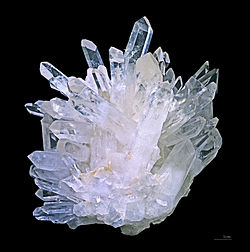Crystal

A crystal is a solid whose atoms (or molecules) are arranged in a repeating pattern.
Crystals are made from fluids by Crystallization, which is a kind of phase change. Usually the fluid is a liquid, but crystals can form from a gas too. For example, snow is water crystals (ice) formed from air that contains water vapor (evaporated water). Crystallization can be by freezing from a simple fluid or from a solution. Sometimes heat and pressure needs to be applied to a substance for crystals to form. Diamond is a carbon crystal formed under heat and pressure. Crystals are found naturally or can be made artificially.
The surface of crystals often have regions that are flat, called facets. Facets occur naturally as crystals form, because flat layers of atoms are usually the most stable. The atoms in a facet are arranged in a regular pattern, such as the pattern of a chess board or a honeycomb. There facets reflect light to give crystals their shiny or sparky appearance. Artificial facets can be made in any shape by cutting or grinding a crystal, which is how some gemstones for jewelry are made.
Different substances form different types of crystals, and some can form more than one type. The study of the arrangement of atoms in crystals is crystallography. Well-known substances that form crystals are table salt (whose crystals are cubes), diamond, and quartz.

Crystal Media
Microscopically, a single crystal has atoms in a near-perfect periodic arrangement; a polycrystal is composed of many microscopic crystals (called "crystallites" or "grains"); and an amorphous solid (such as glass) has no periodic arrangement even microscopically.
As a halite crystal is growing, new atoms can very easily attach to the parts of the surface with rough atomic-scale structure and many dangling bonds. Therefore, these parts of the crystal grow out very quickly (yellow arrows). Eventually, the whole surface consists of smooth, stable faces, where new atoms cannot as easily attach themselves.
Vertical cooling crystallizer in a beet sugar factory.
Two types of crystallographic defects. Top right: edge dislocation. Bottom right: screw dislocation.
Twinned pyrite crystal group.
The material holmium–magnesium–zinc (Ho–Mg–Zn) forms quasicrystals, which can take on the macroscopic shape of a pentagonal dodecahedron. Only quasicrystals can take this 5-fold symmetry. The edges are 2 mm long.
Insulin crystals grown in earth orbit. The low gravity allows crystals to be grown with minimal defects.
Related pages
More reading
- Iggulden, Hal; Iggulden, Conn (2007). "Making Crystals". The Dangerous Book for Boys. New York: HarperCollins. pp. 73–74. ISBN 978-0061243585.
Other websites
- Crystal – Citizendium
+{{{1}}}−{{{2}}}









